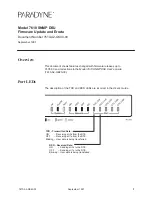
Viper SC+™ IP Router for Licensed Spectrum PN 001-5008-000 Rev. C
| Page 51
If a remote Viper becomes completely unreachable or is disconnected, all packets destined for that unit will be
transmitted the maximum number of times since the packet is never correctly received. Continually transmitting
and retransmitting packets to an unreachable remote will reduce available bandwidth to the remaining functional
Vipers.
Setting data retries to zero yields the maximum throughput since no RF acknowledgement s are transmitted over
the air. However, enabling data retries will provide the maximum level of reliability of the network.
Valid settings for data retries are values in the range of zero (off) to ten (0 to 10), inclusive. The default setting is 2.
Note:
When Data Retries is set to Off, the unit is in “No Acks Required” mode. All other settings enable
Acknowledgements.
Collision Avoidance
When enabled, the collision avoidance feature will transmit a short two-way handshake between the transmitting
and receiving Viper. This tells any adjacent Vipers that a data transmission will be taking place. Adjacent Vipers will
wait until the data transmission is complete before they try to capture the air by sending a new packet.
This feature is particularly useful when remote Vipers are located at sites where they are unable to hear each
other transmit directly and both remotes want to transmit data to the same base station at the same time. In this
scenario they may often try to transmit at the same time yielding a corrupted message at the base station.
The two-way handshake reserves airtime from the network for the packet transmission. It will however add a small
fixed latency to each packet. The added latency is small relative to the time it takes to transmit a large packet
when the chance of collision is greatest. However, when short packets need to be transmitted, it can sometimes
take just as long to complete the two-way handshake as it does to send the short packet.
For this reason, the collision avoidance parameter allows the user to specify the packet size threshold above which
the two-way handshake is implemented. For example, if the Collision Avoidance is set for 128, the Viper will
complete a two-way handshake before sending packets that are larger than 128 bytes, reducing potential
congestion. The Viper will
not
complete the two-way handshake before sending packets that are smaller than 128
bytes, improving throughput.
Setting collision avoidance to a value of 1500 or above effectively disables the feature, as the maximum data
packet size is 1500 Bytes. Valid settings are Off, or values in the range from 0 to 512, inclusive. The default value is
128.
Random Backoff
When a data transmission competes in a busy network, there may be several new Vipers waiting to send data. If all
of these Vipers start transmitting at the exact same time, collisions will occur. To reduce the chance that more
than one Viper starts transmitting at a time, the user can enable a random backoff. The Viper will randomly pick a
time slot to begin its transmission. The user can specify the maximum number of time slots that the viper will wait
before it starts transmitting. If the Viper detects that another unit started transmitting before itself, it will wait
until their data transmission is complete before tries to capture the air again.
Each time slot is equal to the time that it takes to complete a collision avoidance two-way handshake. If the user
specifies a random backoff of 4, then the Viper will wait up to a maximum of 4 time slots before it starts its
transmission. On each new transmission, the Viper radio will randomly pick a time slot (from the time slot number
zero, up to the maximum time slot) to begin its transmission.
















































